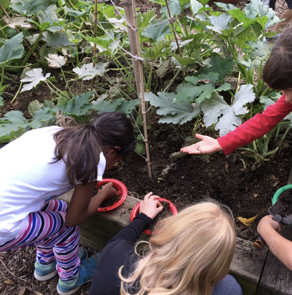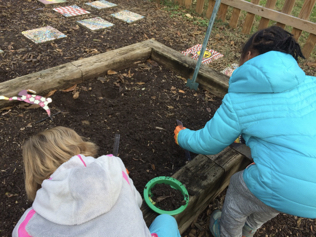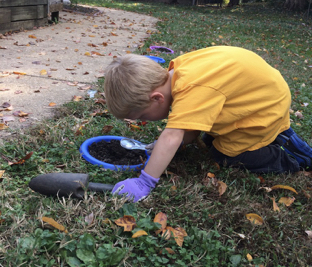Engaging Young Learners in the Practices of Science – Starting with Questions about Earthworms
By Peggy Ashbrook
Posted on 2019-03-04
Welcome to guest blogger Margaret Egan who has dual roles at Tuckahoe Elementary School in Arlington, VA: Outdoor Learning Coordinator and S.T.E.A.M. Teacher. She is a National Board Certified teacher with master’s degrees in both science and education, and has worked as a naturalist and environmental scientist before becoming a teacher. This background facilitates her efforts to weave meaningful age-appropriate curriculum-based content into a wide variety of learning experiences through Tuckahoe’s Discovery Schoolyard. Outdoor learning provides opportunities to engage children in S.T.E.A.M. (science, technology, engineering, art, math) activities, and to nurture their sense of environmental stewardship. Discussing how animal adaptations have inspired human innovation, exploring patterns, carrying out science investigations, and planting gardens are examples of engaging experiences that foster critical thinking, communication, and collaboration skills.
 Many times, I have taken groups of young students (Pre-K through early elementary) outside only to have learning activities sidetracked by the discovery of earthworms! These gentle little creatures become the focus of students’ attention, generating excitement and conversation. Over time, I have come to view earthworms as a wonderful starting place for various types of learning. While instruction of this type can seem unstructured, it is not aimless. According to the NSTA position statement on Elementary Science Education, “High-quality elementary science education is essential for establishing a sound foundation of learning in later grades, instilling a wonder of and enthusiasm for science that lasts a lifetime.”
Many times, I have taken groups of young students (Pre-K through early elementary) outside only to have learning activities sidetracked by the discovery of earthworms! These gentle little creatures become the focus of students’ attention, generating excitement and conversation. Over time, I have come to view earthworms as a wonderful starting place for various types of learning. While instruction of this type can seem unstructured, it is not aimless. According to the NSTA position statement on Elementary Science Education, “High-quality elementary science education is essential for establishing a sound foundation of learning in later grades, instilling a wonder of and enthusiasm for science that lasts a lifetime.”
Content related to core science concepts such as food chains, ecological relationships, and scientific investigation is taught at increasing levels of depth and detail through the grades. Content information is more meaningful to students when they have that first-hand experiential foundation, and have maintained their sense of wonder. Studying earthworms through both relatively unstructured discovery learning experiences and highly structured lessons provides ideal opportunities to engage students in the practices of science and engineering identified as essential in the Next Generation Science Standards (NGSS) and A Framework for K-12 Science Education.
1. Asking questions (for science) and defining problems (for engineering)
2. Developing and using models
3. Planning and carrying out investigations
4. Analyzing and interpreting data
5. Using mathematics and computational thinking
6. Constructing explanations (for science) and designing solutions (for engineering)
7. Engaging in argument from evidence
8. Obtaining, evaluating, and communicating information
The learning process described in the NGSS Framework combines concept learning with practice in the context of investigation and problem-solving. The eight practices are meant to be accessible at some level to all students, starting in kindergarten and growing in complexity through the grades. They may overlap and interconnect but tend to arise sequentially in the course of investigations. Thus “asking questions” is a natural place to begin. Classroom discussion often leads to student-generated questions such as those below, suitable for investigation and related to the NGSS Practices, listed below.
 What is an earthworm? Students can be guided to make detailed observations, and to use specific and descriptive language. Guidance may include encouragement to be specific and avoid using words that mean different things to different people. Rather than describing a worm as weird, cool, or icky, a scientist might say wiggly, pink, or wet. As students inevitably discover a variety of wonders, such as worm eggs, centipedes, and grubs, opportunities abound to encourage critical thinking related to classification. Questions such as, “Does it have legs?” “Does it move like a worm?” and “Did you find it in the same place as the worms?” help students to notice the characteristics of living things and use them to make distinctions. Students can gather information about the characteristics of various groups of animals and engage in evidence-based argument about which group worms belong to, based on appearance and behaviors. Teaching students to add “because” to their statements is a simple but powerful way to encourage evidence-based reasoning, such as “I think this worm is a baby because it is smaller than my fingertip.”
What is an earthworm? Students can be guided to make detailed observations, and to use specific and descriptive language. Guidance may include encouragement to be specific and avoid using words that mean different things to different people. Rather than describing a worm as weird, cool, or icky, a scientist might say wiggly, pink, or wet. As students inevitably discover a variety of wonders, such as worm eggs, centipedes, and grubs, opportunities abound to encourage critical thinking related to classification. Questions such as, “Does it have legs?” “Does it move like a worm?” and “Did you find it in the same place as the worms?” help students to notice the characteristics of living things and use them to make distinctions. Students can gather information about the characteristics of various groups of animals and engage in evidence-based argument about which group worms belong to, based on appearance and behaviors. Teaching students to add “because” to their statements is a simple but powerful way to encourage evidence-based reasoning, such as “I think this worm is a baby because it is smaller than my fingertip.”
How does an earthworm move? Making models is a great way to explore this question. Simple worm models may include an accordion-folded strip of paper, the bendy section of a straw, or a rubber band. Comparing students’ models to real worms, and analyzing differences, allows students to make decisions about possible improvements to the models.
Are there different types of earthworms? Students will likely encounter earthworms with varying characteristics, such as large, small, green, or pink. Keeping data on the number of each type found can be as simple as making tally marks with chalk on a nearby paved surface. Math and computational thinking can be applied to the data as students analyze the differences in the numbers of worms in each category. Guiding questions help students apply knowledge and reasoning to construct explanations, and to argue for them using evidence. Such questions might include: Do all the worms move in the same way? Do they have the same type of rings on their bodies? Did you find them in different places? Do you think they all eat the same type of food?
Where are earthworms? I have found that students will enthusiastically and with great focus dig in various spots, gathering information about where most worms can be found. They use their information to construct explanations, for example saying that worms are near plant roots for food or a pile of leaves for warmth. This question also provides a chance to practice measurement and mathematical thinking as students gather and evaluate the number and size of worms and how deep in the soil they are found. For young children, measurement can begin when they make comparisons; by first grade students typically can use rulers to generate their data. Comparing the location of worms during warm months vs cold is an engaging starting place for planning and carrying out an investigation.
Can worms tell light from dark, and do they have a preference? A simple experimental set-up involving a plastic plate (and water spray bottle to keep it moist), and a piece of dark paper to cover one side can serve as a model for light vs. shaded areas that a worm might encounter in its natural habitat. As students carefully place worms in the center of the plate, they can gather data about their behavior, which will prompt further science practices, including analysis and communication of findings.
This question encourages young students to apply their observations in making inferences in relation to a larger science question, “What are the needs of living things?” which they will return to in later grades. One of my most rewarding experiences as a teacher occurred when I took first graders outside in late fall to try to figure out why earthworms were less prevalent in soil at that time of year. While I thought students might conclude that the worms had simply gone deeper, I was awed by the number of inferences students generated. For example, “Maybe the worms moved closer to the plant roots,” “Maybe the worms laid eggs then died,” and “Maybe the worms moved closer to the school building where it is warmer,” were ideas generated by students. They enthusiastically tested their suppositions by looking for worms in various locations.
Inferring arises naturally from observation, and the differences between these two skills is something students typically explore in upper elementary or middle grades. For younger children, practice with inference comes naturally when they have a high-interest subject, and can be encouraged with guided inquiry. Specific questions, such as, “Why is the earthworm wiggling?” or “Why is that worm smaller than the others?” help students to connect their observations to possible explanations. Going a step further, the article, “What is a Good Guiding Question?” (Traver 1998) states, “Choosing the right questions can lead learners to higher, more meaningful achievement.”
During earthworm investigations, communication will take on many forms, from informal chatter while digging in soil to formal in-class reporting of experimental findings. Communication is facilitated when students have a high-interest subject that they care about.
Working with earthworms also provides chances to model and practice empathy and kindness. Occasionally, a student may express fear or reluctance to work with worms. In this case, it is important for the teacher to provide alternatives, such as allowing that student to be an observer and data recorder, and never forcing a student beyond their comfort zone. This situation provides classmates opportunities to be kind and helpful to the fearful student.
Of course, an attitude of kindness towards the animals encountered in soil studies, such as worms and insects, is important too. It is also in keeping with NSTA position statement guidance, which recommends, in part, “Espouse the importance of not conducting experimental procedures on animals if such procedures are likely to cause pain…” Once students understand, for example, that worms must be kept moist and returned to their homes, they are usually eager to ensure the worms’ safety.
Many students will have heard that it is fine to cut a worm in half because the two parts will just regrow. Showing them that worms are complex animals, with muscles, hearts, and nerves – in some ways similar to people – helps to dispel this misconception. The NRC publication How Students Learn (Chapter 11) includes the statement, “Learning is an active process. We need to acknowledge students’ attempts to make sense of their experiences and help them confront inconsistencies in their sense making.”
Earthworms may be easy to find in a garden bed or patch of schoolyard. For safety, it is best to check out the area first with an eye out for dangers such as thorny plants or poison ivy. For indoor learning, keeping a classroom vermicomposting bin is not difficult and makes a great starting point for lessons on food webs. Knowledge of the proper set-up and maintenance requirements, and some “starter worms” of the right species (different than those found outside) are keys to success (see Resources).
One factor that makes earthworm studies very doable, is that the materials needed are simple reusable items such as plastic trowels, plastic plates, and magnifying lenses. In my experience as a science, STEAM, and outdoor educator, I have found few things that compare with earthworms for sparking wonder and fully engaging students in the practices of science.
RESOURCES
Article:
Traver, Rod. 1998. What is a Good Guiding Question? Choosing the right questions can lead learners to higher, more meaningful achievement. Educational Leadership. March 1998.Association for Supervision and Curriculum Development. 55(6): 70-73. https://mtpyph.weebly.com/uploads/9/0/6/9/9069240/traver_-_good_guiding_question.pdf
Website:
University of Illinois Extension. Urban Programs. The Adventures of Herman.
This is a wonderful, rich, kid-friendly source of information on earthworm biology, very useful for launching discussion of worms as organisms that sense and respond to their environment. https://extension.illinois.edu/worms/
Children’s Books:
Cronin, Doreen. 2004. Diary of a Worm. London: Joanna Cotler Books.
Glaser, Linda. 1994. Wonderful Worms. Minneapolis, MN: Millbrook Press.
Himmelman, John. 2001. An Earthworm’s Life. Chicago, IL: Children’s Press.
Pfeffer, Wendy. 2008. Wiggling Worms at Work. New York, NY: HarperCollins.
Books:
Appelhof, Mary, & Joanne Olszewski. 2018. Worms Eat My Garbage: How to Set Up and Maintain a Worm Composting System. North Adams, MA: Storey Publishing.
National Research Council (NRC). 2005. How Students Learn: History, Mathematics, and Science in the Classroom. Washington, DC: The National Academies Press. https://www.nap.edu/catalog/10126/how-students-learn-history-mathematics-and-science-in-the-classroom
Disclaimer: The views expressed in this blog post are those of the author(s) and do not necessarily reflect the official position of the National Science Teaching Association (NSTA).







